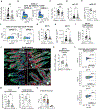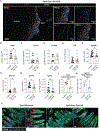Mast cells help organize the Peyer's patch niche for induction of IgA responses
- PMID: 38427721
- PMCID: PMC11008922
- DOI: 10.1126/sciimmunol.adj7363
Mast cells help organize the Peyer's patch niche for induction of IgA responses
Abstract
Peyer's patches (PPs) are lymphoid structures situated adjacent to the intestinal epithelium that support B cell responses that give rise to many intestinal IgA-secreting cells. Induction of isotype switching to IgA in PPs requires interactions between B cells and TGFβ-activating conventional dendritic cells type 2 (cDC2s) in the subepithelial dome (SED). However, the mechanisms promoting cDC2 positioning in the SED are unclear. Here, we found that PP cDC2s express GPR35, a receptor that promotes cell migration in response to various metabolites, including 5-hydroxyindoleacetic acid (5-HIAA). In mice lacking GPR35, fewer cDC2s were found in the SED, and frequencies of IgA+ germinal center (GC) B cells were reduced. IgA plasma cells were reduced in both the PPs and lamina propria. These phenotypes were also observed in chimeric mice that lacked GPR35 selectively in cDCs. GPR35 deficiency led to reduced coating of commensal bacteria with IgA and reduced IgA responses to cholera toxin. Mast cells were present in the SED, and mast cell-deficient mice had reduced PP cDC2s and IgA+ cells. Ablation of tryptophan hydroxylase 1 (Tph1) in mast cells to prevent their production of 5-HIAA similarly led to reduced PP cDC2s and IgA responses. Thus, mast cell-guided positioning of GPR35+ cDC2s in the PP SED supports induction of intestinal IgA responses.
Conflict of interest statement
Competing interests.
D.S. is a founder of and holds stock in Pliant Therapeutics and a member of the Scientific Advisory Board for Genentech and Amgen. J.G.C. is a member of the Scientific Advisory Board of BeBio Pharma and consults for Lycia Therapeutics and DrenBio Inc. All other authors declare that they have no competing interests.
Figures




References
Publication types
MeSH terms
Substances
Grants and funding
LinkOut - more resources
Full Text Sources
Molecular Biology Databases
Miscellaneous

